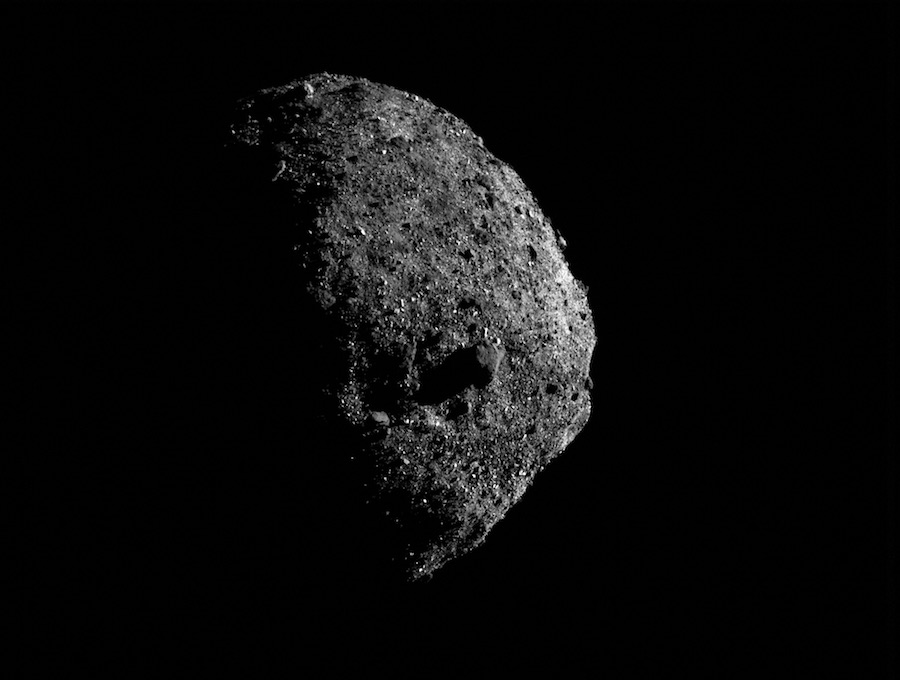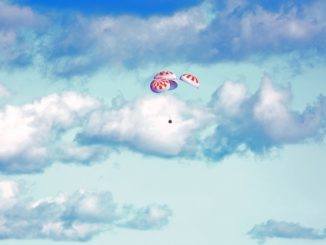
The sampling mechanism on NASA’s OSIRIS-REx spacecraft is stuffed with specimens captured from asteroid Bennu earlier this week — so full that some of the rocks are floating out into space.
Officials said Friday they will stow the samples inside the mission’s Earth return capsule sooner than planned to minimize the loss of asteroid material.
“We had a successful sample collection attempt, almost too successful,” said Dante Lauretta, the mission’s principal investigator from the University of Arizona. “Material is escaping, and we’re expediting stow as a result of that.”
NASA’s $1 billion Origins, Spectral Interpretation, Resource Identification, Security, Regolith Explorer aims to become the first U.S. spacecraft to complete a round-trip journey to an asteroid.
After a nearly two-year close-up survey of asteroid Bennu — a clump of rock measuring a third of a mile (500 meters) wide — the OSIRIS-REx spacecraft descended to the airless world Tuesday for a celestial smash and grab. Its goal was to capture at least 2.1 ounces, or 60 grams, of pebbles, rock fragments and dust particles for return to Earth.
Scientists in sophisticated terrestrial laboratories will scrutinize the asteroid samples, which might contain carbon-rich organic molecules and other minerals containing water. Both types of specimens were part of the primordial soup of ingredients that seeded life on Earth.
Data and imagery relayed to Earth from OSIRIS-REx earlier this week indicated the spacecraft performed as intended, with its Touch and Go Sample Acquisition Mechanism, or TAGSAM, robotic arm contacting the asteroid for six seconds Tuesday. A high-pressure bottle of nitrogen gas at the end of the 11-foot (3.4-meter) arm fired to force surface material from Bennu into a collection chamber, acting like a reverse vacuum cleaner.
The head at the end of the TAGSAM arm is about the size of a dinner plate. The OSIRIS-REx spacecraft and its sampling system were designed and built by Lockheed Martin.
OSIRIS-REx pulsed thrusters to take off from the asteroid after six seconds, officials said.
Lauretta said Friday he is “highly confident” the sample collection attempt was successful, and that it collected “abundant mass, definitely evidence of hundreds of grams of material, and possibly more.”
“My big concern now is that the particles are escaping because we’re almost a victim of our own success here,” Lauretta said Friday afternoon in a conference call with reporters.
Ground teams got their first glimpse of the sample collection device with a series of images downlinked by the spacecraft Thursday. OSIRIS-REx moved the robotic arm into position for a close-up view by the mission’s sample camera, or SamCam.
“We looked at the sample head, and it’s full of sample material, much more than 60 grams,” said Thomas Zurbuchen, associate administrator for NASA’s science mission directorate.
“There is so much in there that the diaphragm that was supposed to keep the sample in is stuck open, and we’ve observed some of the sample pieces escaping into space,” Zurbuchen said. “Therefore, now time is of the essence.”
Lauretta said the images showed around five rocks lodged in the opening of the sample collection chamber. The particles are right at the size limit to enter the sampling mechanism, and they appear to have wedged open a mylar flap, which acts as a lid on the sample head.
The movement of the TAGSAM arm Thursday likely contributed to the loss of some of the samples observed in the images beamed back to Earth. Lauretta estimated that 5 to 10 grams of “flaky” material could have been lost from the TAGSAM head Thursday “in a worst-case estimate” as the samples were disturbed by the arm’s movements.
With the robot arm motionless, managers have seen less evidence of a particle cloud around the spacecraft in images from OSIRIS-REx’s star tracker navigation camera.
Mission managers originally scheduled a sample mass measurement Saturday, during which OSIRIS-REx would extend its sampling arm as it entered a spin to measure the spacecraft’s moment of inertia. Ground teams planned to compare the data to a similar maneuver performed before OSIRIS-REx collected its sample from Bennu to estimate the mass of fresh asteroid material inside the TAGSAM head.
If the estimate indicated OSIRIS-REx had captured more than 60 grams of asteroid samples, plans called for stowage of the specimens inside the return carrier in early November. If not, there was an opportunity for OSIRIS-REx to try another sample collection run on Bennu in January.
With the images downlinked Thursday, officials are now sure the spacecraft grabbed enough of a sample to meet the mission’s minimum success criteria.
“I made the decision to forego the sample mass measurement, and asked the team to prepare immediately to do the analysis to see whether we’re ready for stow,” Zurbuchen said.
NASA announced the Friday afternoon press briefing less than hour ahead of time. Thomas Zurbuchen, head of NASA’s science mission directorate, apologized for the late notice.
“I’m sure you were planning something else tonight,” Zurbuchen said. “I doubt though that it would be more exciting than what we’re going to talk about here.”
The next step for OSIRIS-REx will be to place the sampling mechanism inside a return capsule mounted on the spacecraft. The 31-inch (0.8-meter) diameter sample return capsule is designed to protect the asteroid sample during re-entry into Earth’s atmosphere Sept. 24, 2023.
“We all have one goal, and that is to bring the maximum sample back to Earth,” Zurbuchen said.
“We do not believe that there is anything we can do with the system that we have to go fix the diaphragm,” Zurbuchen said. “So the variables that we can control are: No. 1, how much we rattle this thing around, so we’ve minimized that with the actions that we’ve taken already, and No. 2, is to shorten the time to get this stowed, at which point the particles are locked into the capsule that will bring them back to Earth.”
Over the weekend, engineers at Lockheed Martin’s control facility near Denver will validate the stow procedure, which did not originally account for the possibility that rock fragments and dust and particles might be leaking out of the sampling mechanism.
Zurbuchen said NASA will also reserve time dedicated to OSIRIS-REx on the agency’s Deep Space Network, a group of large tracking and communication antennas at sites in California, Australia, and Spain. He said engineers at the space network will prioritize OSIRIS-REx’s “contingency operations” to ensure the mission gets continuous communications coverage as ground teams command the delicate sample stow procedure.
On Monday, spacecraft operators near Denver will check out a camera looking at OSIRIS-REx’s sample return capsule to monitor the stow operation. If all goes according to plan, mission control could begin placing the asteroid specimens inside the return carrier as soon as Tuesday, Lauretta said.
The ground team will uplink commands for OSIRIS-REx to stow its sample in a series of steps, allowing engineers to regularly pause and assess the situation. Lauretta said the motion involved with the stow operation will likely cause more particles to leak out of the sampling system, and managers want to make sure the material doesn’t interfere with any mechanical interfaces or damage the return capsule.
It will all play out more than 200 million miles (320 million kilometers) from Earth, with a communications delay of more than 18 minutes.
“We can command the arm to move … acquire an image, download that image, analyze it, and then make a decision,” Lauretta said. “Did we see a particle that looks like a mechanical interference? And then what do we want to do to mitigate that as we move forward? So it’ll be very slow and deliberate and play out over several days of activity.”
Officials hope the specimens could safely be sealed inside the sample return capsule by the end of next week.
After the opening the sample return carrier’s lid, ground teams will send commands for the robotic arm to place the TAGSAM head onto a capture ring inside the capsule. Then it will activate a “tube cutter” to cut lines leading from the device’s nitrogen gas bottles, and fire a separation bolt to sever the TAGSAM head from the robotic arm.
“So that is a one-way ticket, and then we move the arm away and the entire head remains inside that capture ring mechanism,” Lauretta. “And then we’ll pull the sample return capsule (lid) down. There are several latches. Only one latch is required for Earth entry.”
Lauretta said he is confident the sample return capsule can seal itself despite the risk of obstructions from floating asteroid particles.
“Once the sample head is safely stowed in the return capsule, it’s closed, it’s protected, and there will no more mass loss,” he said.
The images of the overflowing sampling mechanism Thursday also prompted officials to cancel a thruster firing Friday to slow OSIRIS-REx’s speed away from Bennu. The burn would have preserved the option for a second touch and go sampling run at Bennu.
“We will not be returning to the asteroid,” Lauretta said. “So we said our goodbye, I believe, to Bennu on Tuesday, and we’re solely focused on stowing the sample safely, and then once that’s done, on preparing for return cruise and Earth return.”
With the decision to skip the sample mass measurement, scientists won’t know exactly how much of Bennu they got until OSIRIS-REx brings the samples back to Earth.
“We were looking forward to the sample mass measurement and the certainty that gave us in terms of planning out the sample analysis activities,” Lauretta said. “But the good news is we see a lot of material.”
OSIRIS-REx will depart the vicinity of Bennu in early March to begin the journey back to Earth. The spacecraft will release the sample return capsule as it approaches Earth, targeting a parachute-assisted landing at the Utah Test and Training Range while the OSIRIS-REx mothership diverts and heads again into the solar system.
Scientists will recover the capsule and transport it to NASA’s Johnson Space Center in Houston, where they will begin analysis of the Bennu specimens inside a pristine astromaterials lab, the same facility that houses lunar rocks returned by the Apollo astronauts.
OSIRIS-REx will bring home the biggest haul of asteroid material ever, but it’s not the only mission with sights on returning samples from an asteroid.
Japan’s Hayabusa 2 spacecraft is on course to release a sample carrier to land in Australia on Dec. 6 with a much smaller load of asteroid material than OSIRIS-REx.
NASA and the Japan Aerospace Exploration Agency have agreed to share a small percentage of the OSIRIS-REx and Hayabusa 2 samples between U.S. and Japanese scientists.

While the mission’s scientific payoff won’t come for another three years, the OSIRIS-REx team is already digging into new data about the surface properties of Bennu. Scientists believe the inside of the asteroid is porous, and the boulders on its surface are low-strength and easily crushable.
An initial assessment of the spacecraft’s motion during the touch and go landing Tuesday suggests OSIRIS-REx’s sampling arm pressed about 2 inches, or 5 centimeters, into the loose dust on Bennu’s surface before firing its nitrogen gas bottle.
“The contact was sensed by the accelerometers on-board the spacecraft,” Lauretta said.
A pogo spring on the robotic arm “did not deflect noticeably at all,” Lauretta said, and the sampling mechanism continued moving into the asteroid’s gravelly surface, reaching a depth of up to 19 inches, or 48 centimeters, before OSIRIS-REx activated its back-away thrusters to take off again.
Then it took another three seconds for the spacecraft’s rocket thrusters put OSIRIS-REx in reverse.
“It took the thrusters an additional three seconds to stop that forward motion, and then begin accelerating backwards, ultimately achieving that 40 centimeter per second (0.9 mph) escape velocity,” Lauretta said. “So that’s a wealth of information that will be provided. It tells us an enormous amount about the material properties of the regolith at the contact point.”
Testing of the OSIRIS-REx sampling system before launch showed that the device was able to scoop up the most rocks and dust when it was able to burrow itself into asteroid-like material.
“I remember early on in development, it was a real question,” Lauretta said. “The mechanical properties of the surface of the asteroid was probably the largest unknown in the mission design. So we had to design, everything from a completely rigid surface like running into a slab of concrete down to what we called the ‘fairy castle’ structure with almost no resistance.
“And that was part of the challenge of the mission was coming up with a design that would operate under all of those different circumstances, maintaining spacecraft safety primarily. We’re definitely on the much softer end of that spectrum. We are seeing that the regolith behaves very much like a granular medium, and it flowed away from the TAGSAM head as we pushed through, and the science team is absolutely ecstatic about the dataset we collected.”
Email the author.
Follow Stephen Clark on Twitter: @StephenClark1.



